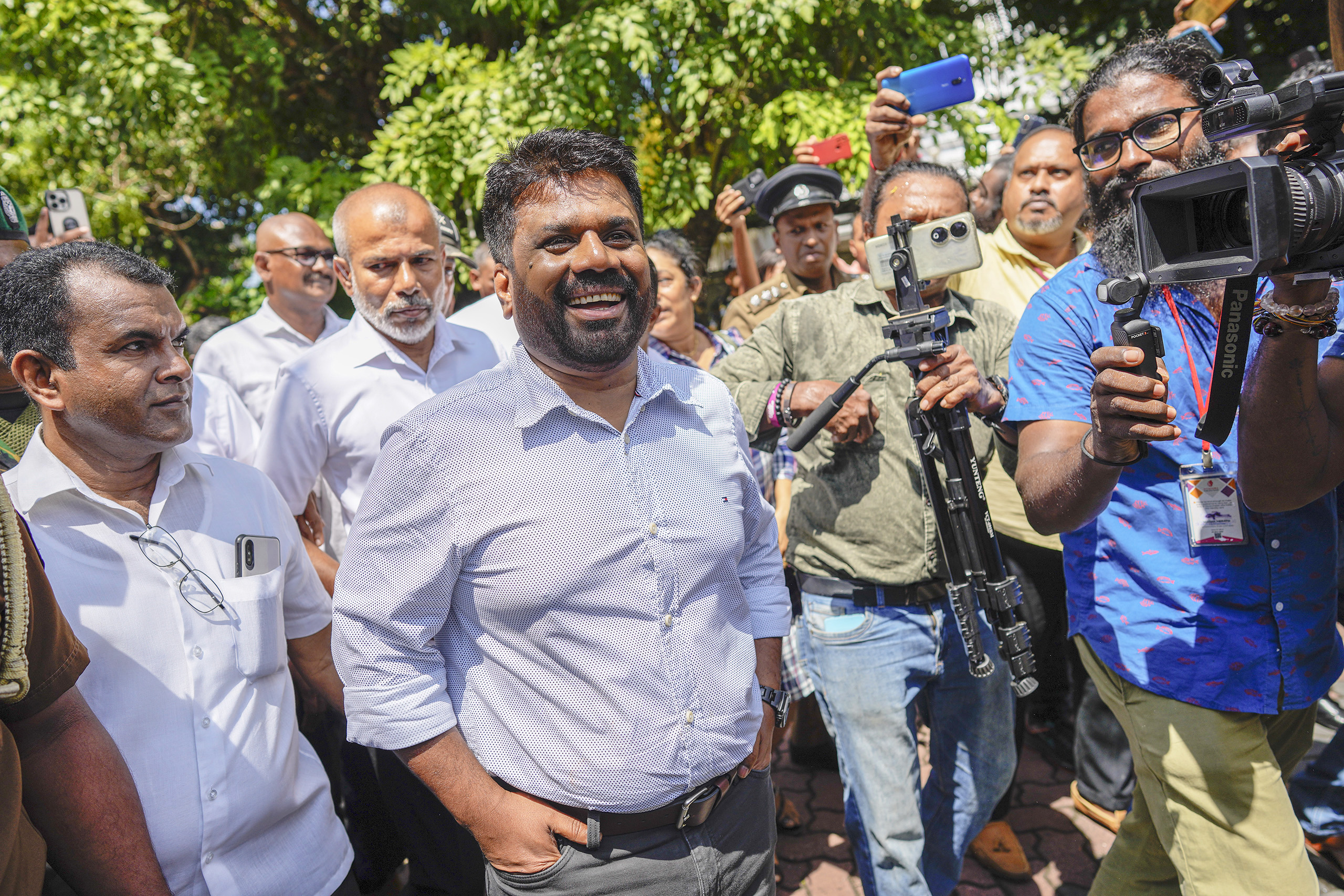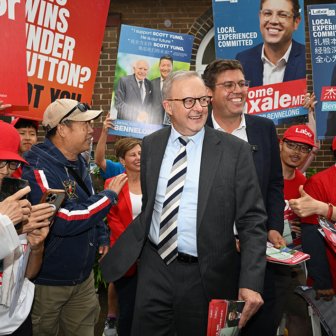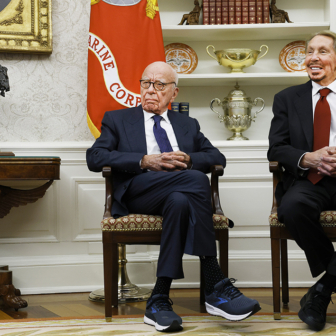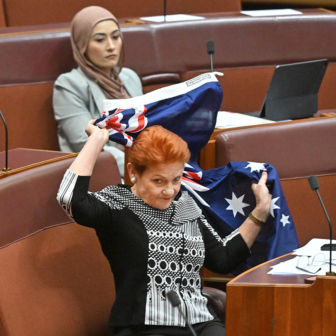“We had one mango, we cut it open and it was rotten,” a Colombo tuk-tuk driver remarked of Sri Lanka’s traditionally dominant political parties a few months before September’s presidential election. “Then we tried another mango, cut it open, and it was rotten too. Now we have a third to try: we’ll cut it open and hope this one is not rotten.” His allegory proved prescient: on 21 September, voters gave leftist leader Anura Kumara Dissanayake a decisive victory, shocking the country’s political establishment and opening a fragile window for democratic reform.
Campaigning in the poll — the first since an economic meltdown and mass protests forced the resignation of president Gotabaya Rajapaksa in 2022 — Dissanayake promised to root out entrenched corruption and bring relief to the millions suffering from a collapse in living standards. His bold promises of “system change” — the key slogan of the 2022 protest movement — have raised expectations among voters that will be hard to meet.
For many, the new president’s modesty and informal style mark a welcome change from the regal pretensions of his predecessors. But he will need extraordinary political skillsand a strong showing by his National People’s Power alliance, or NPP, in next month’s parliamentary elections if he is to avoid the fate of Sri Lanka’s previous democratic openings in 1994 and 2015. While these are early days, his first weeks in office have featured pragmatic concessions to economic realities combined with senior appointments that suggest a willingness to shake things up.
Raised in a rural, Sinhala-speaking family of very modest means, Dissanayake — popularly known as AKD — is the first Sri Lankan head of state from a wholly Sinhala-speaking background. He is also advised by largely Sinhala-speaking team, a major change for a country whose political leadership has either been from the English-speaking elite or the privileged sections of Sinhala society.
As the head of the NPP, a political alliance dominated by his own Janatha Vimukthi Peramuna (the People’s Liberation Front, or JVP) party, whose roots are firmly in the Marxist-Leninist tradition, Dissanayake is also the first head of state not from one of Sri Lanka’s two traditional political blocs, currently led by the centre-left Sri Lanka Podujana Peramuna and the centre-right Samagi Jana Balawegaya.
The campaign, which was one of the most peaceful in Sri Lanka’s history, was dominated by debate over two closely connected issues: how to relieve the widespread suffering stemming from the country’s debt crisis and ensure a sustainable economic recovery, and who was best placed to fight corruption, which many voters believe contributed to the economic crisis and continues to benefit the wealthy and politically connected at their expense.
Dissanayake made the most convincing case to be the inheritor of the 2022 aragalaya (Sinhala for “struggle”) protest movement, with its call for root-and-branch reform of the political system (“system change”). He promised a major crackdown on corruption and revisions to the economic reform package mandated by the government’s 2023 bailout agreement with the International Monetary Fund, in order to bring more relief to middle and lower-income Sri Lankans.
Similar promises from Samagi Jana Balawegaya’s Sajith Premadasa failed to resonate with voters who wanted deep change. Likewise, sitting president Ranil Wickremesinghe’s attempt to capitalise on his success in pulling Sri Lanka out of the worst aspects of the 2022–23 economic crisis failed to win over the large numbers of voters angry at their economic plight and continued corruption.
Dissanayake faced considerable resistance too, but from other quarters, including wealthier voters and those concerned about the JVP’s role in violent uprisings in 1971 and 1987–90, during which it killed, often in gruesome ways, thousands of those it accused of opposing its goals. The NPP, under whose banner AKD ran, was created partly to bring in civil society and workers’ organisations and public figures unconnected to the JVP’s past violence and Marxist ideology, even as the party remains the dominant force in the alliance.
Interestingly, while Dissanayake ran on a left-populist platform sharply critical of the IMF and promising economic relief, polling just prior to the election indicates he owes his victory less to poor or rural voters than to urban and suburban middle-class voters. Long concerned about corruption by politicians and the politically-connected, this section of the population is now angry at the role of the political class in the dramatic drop in their living standards since 2020. With the JVP having been in government only once, as junior partners in a brief coalition twenty years ago, Dissanayake was well-placed to tap into potent anger at both economic suffering and corruption, and, most important, at the out-of-touch and destructive political class responsible for both.
For some voters, Dissanayake and the JVP were a risk worth taking given the devastating failures of the political establishment. For many others, desperate for change, Dissanayake’s campaign was a source of hope and inspiration. Many younger supporters poured their energies into the NPP’s two years of patient, local-level mobilisation, which was notable for its unprecedented outreach to women, and Dissanayake’s frequent overseas trips seeking support and money from Sri Lankans living overseas.
Dissanayake’s victory marks the entry of a very different class into the centre of power, at least partially displacing the networks that have run the country for decades. His early weeks in office have shown a change of style that expresses this shift and seem to signal deeper changes ahead. In a short speech following his swearing-in as president on 23 September, he promised to respond to the “urgent need to cultivate a more ethical and transparent political culture”.
“I am not a magician,” Dissanayake added, striking a distinctly modest tone. “I am simply an ordinary citizen of this country, with both strengths and limitations, knowledge and gaps… It is my responsibility to be part of a collective effort [and] every citizen and professionals from all sectors share a crucial responsibility in overcoming this crisis.”
Dissanayake’s choice of Harini Amarasuriya as prime minister is also significant. A feminist academic who has only been in politics since 2019 and is not affiliated to any party, she is Sri Lanka’s first woman prime minister with no links to a political dynasty, and has become one of the country’s most popular politicians in record time. Her appointment marks — and is meant to mark — a shift from the traditional, doctrinaire leftism of the JVP to the more liberal and inclusive leftism of the NPP alliance.
Dissanayake was elected for a five-year term but only three members of the NPP sit in the incumbent parliament. As expected, he dissolved the assembly immediately after his election, opening the way for fresh elections on 14 November. The success of his presidency will depend in large part on the NPP’s ability to win a working majority in parliament. Given the disarray and fracturing of other political alliances and Sri Lanka voters’ tradition of endorsing the party of the victorious presidential candidate, the NPP stands an excellent chance.
Dissanayake used his first weeks in office to make a series of decisions on economic matters that point to greater pragmatism than many observers anticipated. Among his initial administrative moves was the re-appointment of the senior bureaucrat in the finance ministry who helped arrange and manage the IMF deal, Mahinda Siriwardena, a clear signal he would not attempt to entirely overhaul the bailout agreement as some feared. On 3 October, the new president then met a visiting team from the IMF and “reaffirmed the government’s broad agreement in principle with the objectives of the IMF program.” The next day, the finance ministry announced the government was going ahead with the debt-restructuring agreement made with international bond holders, and “confirm[ed] their endorsement of the [IMF] program debt targets.” While these moves partially quieted concerns that the new administration would adopt a confrontational approach towards the IMF, they also exposed major tensions in Dissanayake’s approach.
Having campaigned on a platform that promised to renegotiate the economic reform program agreed with the IMF and to reopen just-concluded negotiations with international creditors so as to win more generous debt relief, the new administration faced a serious bind. Rejecting the just-finalised debt-restructuring deals — which many experts believe favour the creditors — would have prolonged an already laborious process, and undermined the confidence of international creditors as well as investors. In the short term, the new administration appears to have calculated that it wasn’t in a strong enough position to resist the demands of the IMF and international creditors.
Dissanayake has not entirely abandoned the goal of winning adjustments to the IMF program, however. During his meeting with the IMF, he reportedly emphasised “the importance of achieving the [IMF program’s] objectives through alternative means that relieves the burden” of those “struggling due to high VAT and income taxes.” On this front, there may be room in the next budget to reduce both taxes for some taxpayers while still meeting the revenue targets agreed to under the IMF deal, partly thanks to the previous government’s success in boosting tax revenues.
Nonetheless, these adjustments can only be quite modest. The IMF’s budgetry targets, which require overall higher tax returns and restraints on government spending, are set by the amount of debt relief provided. As a result, the new president’s accommodative stance towards Sri Lanka’s creditors and his decision not to challenge the IMF’s calculation of how much debt Sri Lanka can manage, leaves him very little room to manoeuvre. With only a modest amount of relief on offer, Sri Lanka will need to generate consistent and significant budget surpluses if it is to service — and hopefully, if slowly, pay down — its debt while also funding essential services.
This leaves the new government with little choice but to build on the success of its predecessor and continue to increase its overall tax revenues, which remain among the world’s lowest. To do so, Dissanayake and the NPP will need to make a serious effort to develop effective wealth and luxury taxes — a step the IMF has been pressing for, but which the Wickremesinghe government failed to get off the ground.
Over the longer term, any sustained relief to struggling Sri Lankans will almost certainly require greater debt relief than what the previous government was able to negotiate from its creditors. The limits of the current round of debt restructuring — which aim to reduce the debt-to-GDP ratio from its high of 126 per cent in 2022 to 106 per cent by the end of the IMF program, in 2027, and then to 95 per cent in 2032 — are therefore likely to return to the centre of public debate. That renewed debate is all the more likely given the advantageous terms international bond holders negotiated, which some analysts argue have increased the possibility of future debt distress.
Ultimately, to reach a point where it is comfortably removed from the threat of a return to debt distress, the Sri Lankan economy needs to grow faster. Dissanayake and the NPP are unlikely to be comfortable following a key aspect of the IMF deal that is distinct from the need for fiscal stabilisation: its largely neoliberal package of “growth-enhancing structural reforms,” which range from more business-friendly labour laws and liberalised land policies to the privatisation of state enterprises.
Whether the NPP can develop an alternative path to growth in a global economy disadvantageous to highly indebted, lower middle-income countries, remains to be seen. Can it develop ways to increase exports without reducing workers’ rights? Can it implement its promise of increased domestic production without falling into the protectionism that has previously propped up non-competitive but politically connected local businesses? And does the NPP have the policy advisers with the economic skill to devise and implement such strategies? Its critics are sceptical.
With no easy or quick fixes available on the economy, Dissanayake and the NPP may hope that strong efforts to investigate and bring to justice to those responsible for high-profile cases of corruption and political crimes could help cushion the effects of popular disappointment at continued economic hardship.
Unlike the deep divisions in civil society and between parties on economic policy, there is wide consensus on the importance of combating corruption, strengthening the rule of law, and ensuring accountability for the country’s political elite. Given how central the fight against corruption has been to Dissanayake’s and the NPP’s political brand and public appeal, successful action will be essential for their credibility.
It won’t be easy. A landmark 2023 study by the IMF showed how deeply embedded “corruption vulnerabilities” were in the workings of government procurement and spending in Sri Lanka. On the urging of the IMF — itself pressured by Sri Lankan and international anti-corruption activists —the Wickremesinghe government took some useful initial steps, passing legislation that strengthened the powers of the anti-corruption commission and initiating work on other laws, including one designed to facilitate the recovery of stolen assets. But that progress was not matched by a willingness to prosecute.
Dissanayake has taken a radically different approach: on his first day in office, he appointed Ravi Seneviratne, retired head of the Criminal Investigation Department, as secretary of the public security ministry, which oversees the police. A few days later, Dissanayake appointed a new chief of police to replace one widely seen as politically compromised.
Seneviratne helped lead investigations into the Easter Sunday suicide bombings of 2019 during his time with the CID, as well as heading probes into numerous cases of alleged murders and disappearances which occurred during the 2005–2015 presidency of Mahinda Rajapaksa. He was forced from his position in 2020 by then-president Gotabaya Rajapaksa — Mahinda’s brother — and has since alleged his removal was part of an effort to block effective investigations into the Easter attacks.
In an interview soon after taking up his new job, Seneviratne promised to reopen investigations into many of Sri Lanka’s best-known cases of large-scale corruption, forced disappearances and political murders. He will be assisted in these inquiries by another of Sri Lanka’s most celebrated CID investigators, Shani Abeysekera, who also rejoins the police in a senior position after being arrested on false charges and hounded into early retirement by Gotabaya Rajapaksa’s administration.
The deadliest of the crimes Dissanayake and the NPP have long promised to re-examine are the 2019 Easter Sunday suicide bombings, which killed more than 270 people and injured twice as many. Despite multiple commissions of inquiry and an ongoing trial, victims’ families, the Catholic hierarchy and much of the public are convinced that those who directed the attack have yet to be identified, and rumours abound about the involvement of government officials. Two weeks into his presidency, on 6 October, the new president visited one of the Catholic churches targeted by the bombings. Fielding questions from survivors and victims’ families, Dissanayake promised a “fair and transparent investigation” and assured them that “justice will be delivered to the victims.” He noted the “growing suspicions that the government apparatus at the time may have been involved in the attacks” and that the “attacks may have been carried out to gain political mileage,” a clear reference to allegations the bombings were planned by senior security officials to boost Gotabaya Rajapaksa’s chances in the 2019 presidential election. The next day, the president appointed a senior police officer as director of the State Intelligence Service, removing Major General Suresh Salley, a former head of military intelligence known to be close to Gotabaya Rajapaksa and implicated by eyewitnesses in the attacks (an allegation he denies).
Earlier political transitions in Sri Lanka have ultimately failed to reduce corruption or better protect human rights, most recently under the so-called yahapalanaya (Sinhala for “good governance”) government of 2015–19. The experience of its chaotic attempts to combat corruption and abuses of power — attempts the JVP supported from outside government — points to the need for careful planning and sequencing of investigations and prosecutions, as well as establishing realistic goals that don’t raise false hopes whose disappointment only adds to public cynicism. Repeated promises then and now that billions of dollars in assets stolen by previous regimes will be recovered are almost certain to remain unfulfilled.
Just as important as pursuing past cases is the need to strengthen the independence of the police, judiciary and oversight bodies such as the human rights and police commissions. Important steps here will include following through on the NPP’s promise to establish a public prosecutor’s office independent of the often-compromised attorney-general’s department. More challenging still is the need to eliminate, through constitutional reform, the presidential system of government and the excessive centralisation of power that has come with it.
Ultimately, though, the question remains whether, despite Dissanayake’s unconventional profile, the new government — unlike any before it — will respect the constraints that come with independent institutions and allow itself to be held accountable. Will the AKD administration accept the essential democratic role of rigorous monitoring of the government by opposition parties, the media and civil society organisations? That would mark the real transformation of the JVP into the NPP.
Missing from the presidential campaign was any serious and sustained attention by the major candidates to Sri Lanka’s perennial source of conflict, the ethnic divide between its Sinhala-speaking, and largely Buddhist, majority and the smaller Tamil and Muslim communities that exist throughout the island but make up the majority in the north and east. While the NPP has distanced itself from the JVP’s traditionally hard-line Sinhala Buddhist nationalism, Dissanayake’s campaign nonetheless made a strong effort to cultivate support from the Buddhist clergy and from the almost-entirely Sinhala military, establishing dedicated NPP wings for both groups. Adding to scepticism among Tamil and rights activists, Dissanayake’s initial appointments have included ex-military officers whose wartime activities have raised concerns about their possible involvement in serious violations of international law.
Much like Mahinda Rajapaksa in the years following his government’s victory over the Tigers, Dissanayake’s Sinhala nationalist background and credibility could, in principle, improve his chances of convincing Sinhala voters to accept policy changes — and perhaps ultimately constitutional action — that empower Tamils and Muslims and offer them at least some justice. While Dissanayake received few votes from Tamil-majority districts (the largest share went to Premadasa) and relied for victory on many of the same voters as Gotabaya Rajapaksa did in his hyper-nationalist campaign in 2019, he is clearly not Mahinda or Gotabaya. His campaign was free from anti-Tamil or anti-Muslim rhetoric, and he has pledged to try to overcome what he acknowledged is the NPP’s difficulty winning support from Tamils.
Speaking in language the Rajapaksas would never have used, Dissayanake has argued that “the problem in Sri Lanka was not the war, the problem took the form of a war. Although the war is over, the national question remains. We believe and accept that there are issues, especially regarding the Tamil and Muslim people of this country, in regard to their language rights, cultural issues as well as their participation in governance. We must find solutions for these pending issues.” Prime Minister Amarasuriya could be an important ally in such efforts, having a long history of support for the rights of Tamils and Muslims and the need for a lasting postwar settlement. But as recent statements indicate there are senior figures in the JVP who will need to be brought on board.
Making progress on these issues — winning the trust of minority Tamils and Muslims while maintaining popularity with the majority Sinhalese — will not be easy. One early test case for the new government will be to take quick action to stop the ongoing campaign by the archaeological department and other government offices, often working with nationalist monks, to seize land held or used – sometimes for religious purposes – by Tamils and Muslims in the north and east of the island.
Putting an end to these ethnically and religiously motivated land grabs — which often rely on active police and military suport — will not be without political risk for Dissanayake and the NPP. But if they aren’t be willing to take these initial steps, there would seem to be little hope for the deeper changes Dissanayake and the NPP say they support: the full and effective implementation of the existing constitutional provisions for provincial autonomy and, more ambitiously, a new constitution that more fully meets long-standing Tamil aspirations for a fair share of power.
Equally if not more distant is any prospect of justice for wartime atrocities committed by government security forces, an issue of great importance for many Tamils and a number of influential foreign governments. In an interview a month before his election, Dissanayake promised his government would work to establish the truth about wartime violations — which many Tamils believe amounted to genocide — but without seeking to punish anyone. This suggests his government could decide to pursue some version of the previous administration’s proposed truth and reconciliation commission, an initiative sharply criticised by Tamil victim’s groups and local and international rights groups for its neglect of the criminal accountability Dissanayake and the NPP call for in other cases.
Dissanayake’s victory is widely interpreted as the delayed political victory of the aragalaya, which in 2022 could not find a political vehicle to carry forward its agenda for “system change.” Yet political and economic cultures don’t change overnight, and Dissanayake will need to administer a state famous for resistance to reform while feeling many of the standard pressures of Sri Lanka politics: supporters’ expectations of government jobs, the power of Sinhala Buddhist nationalism, the Buddhist clergy, and the disproportionate influence of military and security apparatus in the state’s functioning.
The NPP’s main constituent, the JVP has itself been no stranger to the darker side of Sri Lankan politics: not just the terrible violence and intolerance of dissent that characterised its two insurrections decades ago, but also its more recent participation in the deal-making and trading of favours that characterises Sri Lankan party politics. While Dissanayake and other key NPP figures have moved a considerable distance from the JVP’s past positions and practices, it remains unclear how the party — and the politburo that sets its policies — will relate to the NPP and Dissanayake now that they are in power.
While the portrait of Rohan Wijeweera, the JVP’s leader during its two uprisings, still hangs over the front reception area of the party’s headquarters outside Colombo, many wonder whether the JVP’s historically rigid ways will eventually resurface in the apparently more supple NPP. That question is more likely to be answered happily if the aragalaya’s other great achievement — the increasing willingness of Sri Lankans to question and challenge those in power — can begin to take on political and institutional forms capable of effectively holding AKD and the NPP to account. •




